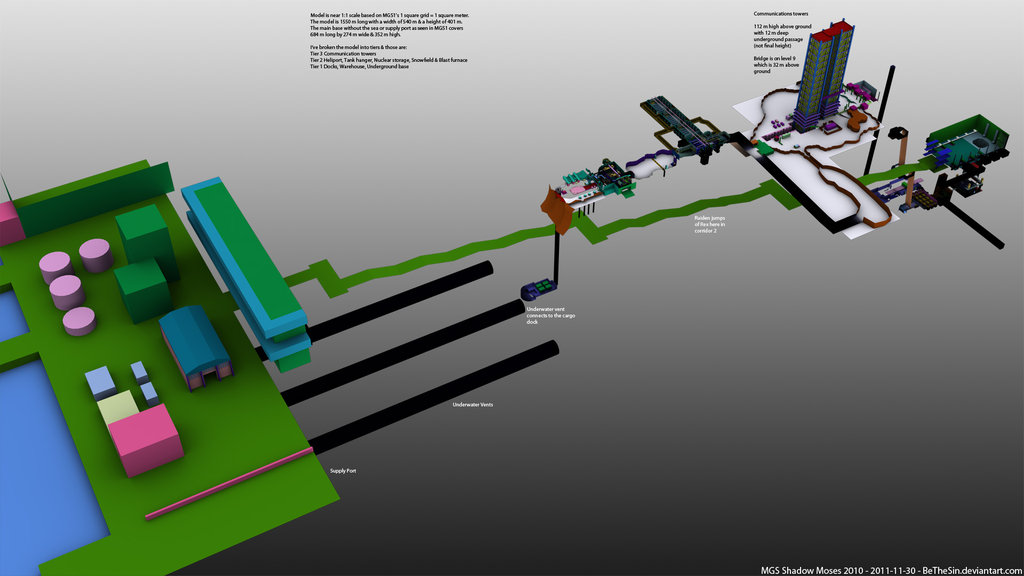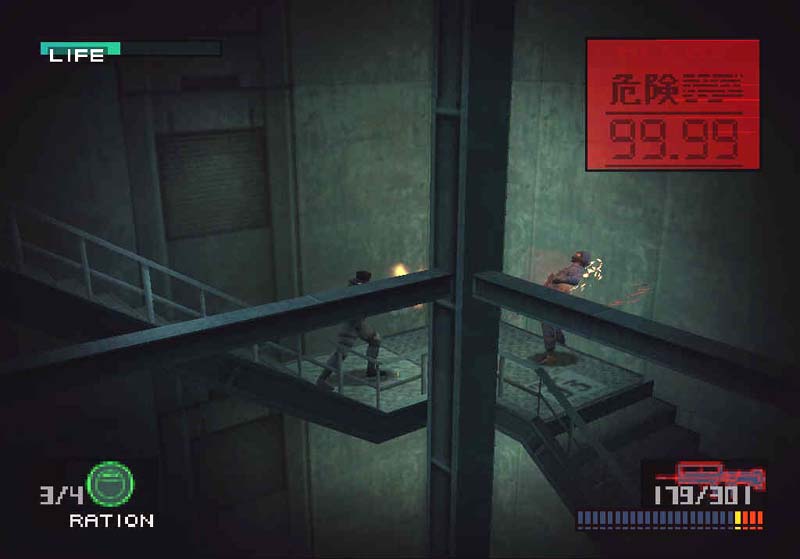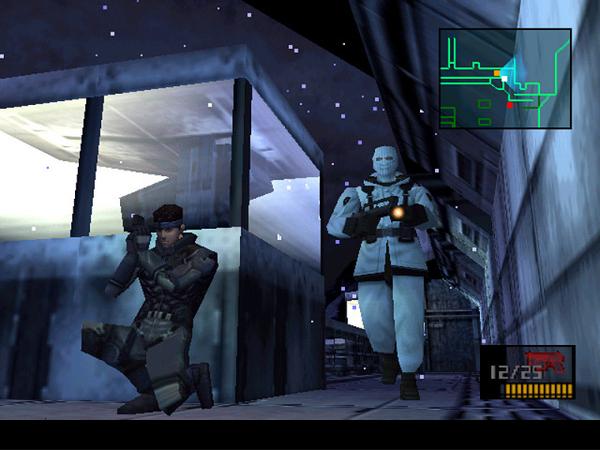Last updated on August 6, 2014
Spoilers, Beware!
I arrive at Metal Gear Solid from a weird angle. For whatever reason, my first entry in the series was Metal Gear Solid 2: Sons of Liberty, and that represents an incredibly strange introduction into the much-venerated series. As a result, I find myself with the enviable position of seeing Metal Gear Solid 2 objectively (without the baggage of the first game), while also being able to see what makes Metal Gear Solid’s original outing such a “classic”, if it even is one.
May as well start from the beginning, then. What constitutes the primary Metal Gear experience? Stealth, of course! Hideo Kojima basically invented this action sub-genre with the original Metal Gear for the MSX home computer. From a reductive perspective, Metal Gear Solid merely builds upon the stealth and story mix that Metal Gear 2 provided Japanese audiences, but for most Americans it represented the first real taste of the series (anyone who knows the series’ convoluted US history knows about the NES Metal Gear games not even being ports or having Kojima involved at all). Although Tenchu predated Metal Gear Solid in the US, MGS really popularized it. So what makes the stealth so distinctive?
Stealth action requires your wits more than your action. Avoiding combat at any and all costs. Gradual advancement of stealth game mechanics along with forced combat sequences. Soliton radar emphasizes the pure puzzle aspects, only showing you possible threats to your person. Many tools exist to allow you to analyze your surroundings in advance, from binoculars to cardboard boxes, but it’s up to the player to formulate a strategy. There’s not often a time limit in the pure stealth sequences, which emphasizes this even more.
I probably should mention, as well, that this is one of the fastest stealth games I’ve ever played. Yes, you still need to plan your movements and check enemy patrols or external dangers, but Solid Snake moves at a surprisingly brisk clip. You’ll never find yourself unable to outrun guards or trapped unless you happen to make a bad judgment. Thus, the onus remains with the player to not place themselves in bad situations. Obviously, Metal Gear Solid plays much slower than a pure action game, but I found myself surprised with the quick pacing by comparison with its descendants in the same sub-genre.
Thankfully, the relatively slow pacing complements the “outdated” controls. The controls remain a problem only because I am playing the game in the year 2014, and we’ve grown used to true analog control and a right thumbstick camera. In 1998, everyone played Metal Gear Solid just fine, and from that perspective Snake controls perfectly fine. Yes, the lack of true dual analog control seems strange (it does support Dual Shock, after all), but the camera angle looks like an intentional design choice when all’s said and done.
The camera looks both cinematic, detailed, AND obscures your view to force you to pay attention to the radar. If the camera zoomed back too far, it would just look silly, but it places you “in the action”, so to speak, without all knowledge of the area at your fingertips. If it exists because of technological limitations, then they work with the puzzle style (aforementioned puzzles prove that), and adding an MGS2-esque control scheme would break certain areas of the game for sure! First person mode exists, of course, but mostly just for observation purposes.
Even though they’re clearly formulated with the game’s mechanics in mind, the level design intends for a level of realism by emphasizing the relatively small size of Shadow Moses. Frequently, you’ll need to backtrack from one area to another, traversing area you once knew and finding the best techniques and shortcuts. Because of this, the game offers rewards to those who bother to wander around and experiment, trying to find out which doors open with certain key cards. You will find new tools, and finding them seems both totally intentional AND optional.
In a way, I understand the complaints of the repetitiveness and backtracking, but you’re in a semi-realistic stealth game. Kojima wants to emulate the real logistics of a base, and that’s probably why stealth receives such an emphasis: to force you to pay attention, just like the radar and the camera angle. Heck, I think I can make that statement based purely on the dozens of cited experts on military information in the credits. You rarely see a video game where the elements of the design complement each other so well even when we could level a criticism. The polish really shines when repetition, and visible repetition at that, turns into an asset.

Of course, Metal Gear Solid still fits precisely in the vein of the old school still while bridging the gap to “modern” gaming, and with that comes a strange but welcome dissonance. The game often encourages exploration and punishes failure. Checkpoints remain frequent even without a save, so retrying never feels like a chore. The difficulty seemed quite high even on normal, but that’s an intentional choice: the more you die, the more you learn and the greater your chance for success next time. If you ever encounter something you either don’t understand or need help to pass, help’s just a codec call away (in that sense, we could call it an optional tutorial – more games could learn from this). Even so, everything works so holistically that you often give it pass for sheer entertainment value (more on that later…)
That stiff challenge allows Metal Gear Solid to use its mechanics to encourage stealth above all. Even on Normal, your health bar takes significant damage with just a single enemy, and most foes will follow you unless you break their line of sight. Killing them won’t stop respawning guards from running to your location; you must evade them somehow, or you will most likely die. I found most situations basically required stealth, and combat never worked for me at all. Why bother using combat, right? Kojima obviously holds an anti-war disposition, and that means we use the interplay of mechanics and story to show the horrors of combat and the selfishness underlying all conflict.
Excepting the giant climb on the communications towers, of course. Why is this in here, I have no idea, but it makes me want to tear my hair out. Either via limitations of the technology on hand or just an intentional design choice for cinematic purposes, this sequence shows the fundamental flaws behind the combat system. While much of the game allows you to avoid it, and bosses allow the player to focus on a single target (for the most part), the run up the tower demonstrates all the worst qualities. It shoehorns an awful camera angle that makes you stick to walls, and then send constantly respawning guards up a stairway. Sound like fun?

You need to shoot them, or else you’ll die, and it’s difficult to see guards ahead of you unless you’ve already taken damage. More than likely, most of your stock of useful ammo and rations will be drained, and there’s really nothing you can do about it. You just need to run and hopefully survive; that philosophy really runs counter to the rest of the game, and the controls just don’t hold up very well. This is the only sequence in the whole game like this, and it really makes no sense to me at all why we shoved this horrible sequence into the game. Only the end-game chase sequence (which forces you to press triangle and square at the same time to shoot with any degree of accuracy) rivals it in terms of sheer, dumb frustration. Can I emphasize enough how bad the shooting is? No? It’s just bad. Having to hold two buttons to aim during the turret sequence at the end is just clunky now, and that part just hasn’t aged well at all.

